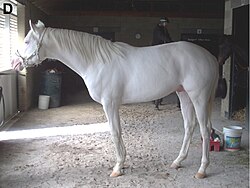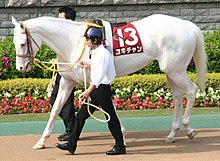White horse
| White horse | |
|---|---|
 Dominant purebred white stallion | |
| Genotype | |
| Base color | Dominant white |
| Skin | White |
A white horse is born predominantly white and stays white throughout its life. A white horse has mostly pink skin under its hair coat, and may have brown, blue, or hazel eyes. "True white" horses, especially those that carry one of the
True white horses

White horses have unpigmented skin and a white hair coat. Many white horses have dark eyes, though some have blue eyes. In contrast to gray horses which are born with pigmented skin they keep for life and pigmented hair that lightens to white with age, truly white horses are born with white hair and mostly pink, unpigmented skin. Some white horses are born with partial pigmentation in their skin and hair, which may or may not be retained as they mature, but when a white horse lightens, both skin and hair lose pigmentation. In contrast, grays retain skin pigment and only the hair becomes white.
White colorings, whether
Dominant white

Dominant white (W) is a large group of
Sabino-white
Sabino-white horses are pink-skinned with all-white or nearly-white coats and dark eyes. They are

White born leopards
The leopard complex, related to the Leopard (LP) gene, characterizes the
Lethal white syndrome
Lethal white syndrome is a genetic disorder linked to the
Horses that appear white, but are not

Genetically white horses have unpigmented pink skin (except where a horse with a W allele may have some darker pigmented areas) and unpigmented white hair, though eye color varies. The lack of pigment in the skin and hair is caused by the absence of pigment-producing cells called melanocytes. Some coat colors are characterized by light or white-like coats and even pinkish skin, however these white-like coats are not lacking melanocytes. Instead, white-like coat colors result from various changes in the ways melanocytes produce pigment.
Gray
Diluted coat colors
True white hair is rooted in unpigmented skin that lacks melanocytes. In contrast, diluted coat colors have melanocytes, but vary due to the concentration or chemical structure of the pigments made by these pigment-producing cells, not the absence of the cells themselves. There are at least five known types of pigment dilution in horses, three which, as described below, can act to produce off-white phenotypes. Horses with strongly diluted coat colors usually have pale eyes (usually blue), cream-colored coats, and rosy-pink skin that contains a minimal amount of pigment. White markings are usually visible upon closer inspection.
- The . A few Palominos have a very light hair coat is occasionally mistaken for either cremello or white. White markings and patterns are visible against the slightly-pigmented coat and skin. The cream gene is not known to be associated with any health problems.
- Pearl-Cream pseudo-double dilute occurs when a horse has one cream gene and one Paint horses, and some Iberian horses.[13]Pearl is not known to be associated with any health problems.
- Champagne-Cream pseudo-double dilute occurs when a horse has one cream gene and one champagne gene. Champagne and cream are another pair of unrelated dilution factors that interact to produce a cremello-like coat. Champagne-creams have freckled, pinkish skin, pale eyes, and pale coats. These colors were formerly referred to as "ivory champagnes".[14] Champagne is found in North American breeds such as the American Cream Draft, Tennessee Walking Horse, American Saddlebred, American Quarter Horse, and Miniature horse. It is not known to be associated with any health problems.
Albinism
Although white horses are sometimes called "albino" there are few cases of a true "albino" horse.[15] There are also references in literature calling white horses "albino".[16] Dominant white in horses is caused by the absence of pigment cells (melanocytes), whereas albino animals have a normal distribution of melanocytes.[17] In other animals, patches of unpigmented skin, hair, or eyes due to the lack of pigment cells (melanocytes) are called piebaldism, not albinism nor partial albinism.
All so-called "albino" horses have pigmented eyes, generally brown or blue. While true albino horses will have a pale blue or white eye. In contrast, many albino mammals, such as mice or rabbits, typically have a white hair coat, unpigmented skin and reddish eyes. The definition of "albinism" varies depending on whether humans, other mammals, or other vertebrates are being discussed.[18]
Despite this, some registries still refer to "albino" horses. For example, the Paso Fino Horse Association registers cremellos and other cream colors as "albino."[19] Until 1999, the American Quarter Horse Association (AQHA) described perlino or cremello horses as "albino" in rule 227(j).[20] The AQHA later replaced the word "albino" with "cremello or perlino," and in 2002 the rule was removed entirely. Among Connemara pony breeders, homozygous creams are called "blue-eyed creams" or sometimes "pseudo-albino".[21]
Types of albinism in humans and other animals
The best-known type of albinism is
Humans exhibit a wide range of pigmentation levels as a species. However, the diagnosis of albinism in humans is based on visual impairment, which has not been described in white horses.[23] Vision problems are not associated with gray, dilute, or white coat colors in horses, and blue eyes in horses do not indicate poor vision. Eyes are pigmented at the front of the iris called the stroma, and in a thin layer at the back of the iris in tissue called the iris pigment epithelium. The iris pigment epithelium prevents damaging light scattering within the eye. Blue-eyed humans and mammals have little or no pigment in the stroma, but retain pigment in the iris pigment epithelium. If pigment is missing from both the stroma and the iris pigment epithelium, the only pigment in the eye is the hemoglobin in blood vessels. This accounts for the reddish appearance of eyes in some types of albinism.[24]
In research mammals, such as mice, albinism is more strictly defined. Albino mice occur due to a recessive mutation of the C gene. No such mutation exists in horses.[15] Albino mice lack pigment, but "...the inability of albino animals to produce pigment stems not from an absence of melanocytes...but from a deficiency and/or alteration of the structure of tyrosinase in melanocytes which are otherwise normal."[17] This definition of albinism in mice – the inability to make tyrosinase – is extended to other mammals.[22]
While mammals derive their pigments only from melanins, fish, reptiles and birds rely on a number of
Why cream is not albino
The cream gene, which is responsible for palomino, buckskin, and cremello coat colors, was mapped to the
Famous white horses
Many famous horses, past and present, were alleged to be "white" by observers, but were actually
Another famous white horse is Sodashi, a Japanese Thoroughbred racehorse who won Grade 1 races including Hanshin Juvenile Fillies, Oka Sho (Japanese 1,000 Guineas), and Victoria Mile.[28][29]
Mythology
Throughout history, white horses have been
See also
References
- ^ "Introduction to Coat Color Genetics" from Veterinary Genetics Laboratory, School of Veterinary Medicine, University of California, Davis. Web Site accessed January 12, 2008
- PMID 18296388. Retrieved 3 July 2009.
Phenotypes may vary from tiny depigmentated body spots to white head and leg markings, further on to large white spotting and finally nearly complete depigmentation in white-born horses...White markings result from the lack of melanocytes in the hair follicles and the skin...A completely pigmented head or leg depends on the complete migration and clonal proliferation of the melanoblasts in the mesoderm of the developing fetus, thus ensuring that limbs and the head acquire a full complement of melanocytes
- ^ Kathman, Lesli(2014). "The Equine Tapestry", p. 83, 90–94. Blackberry Lane Press.
- ^ "YUCHICHAN".
- ^ a b c UC Davis. "Horse Coat Color Tests". Veterinary Genetics Laboratory. University of California – Davis. Retrieved 8 July 2009.
Horses with 2 copies of the Sabino1 gene, are at least 90% white and are referred to as Sabino-white.
- ^ Brooks, Samantha (2005). "The SNP was found among American Miniature Horses, American Paint Horses, Azteca, Missouri Fox Trotters, Shetland Ponies, and Spanish Mustangs."
- ^ Sheila Archer (3 August 2008). "Studies Currently Underway". The Appaloosa Project. Retrieved 4 November 2008.
- ^ "Die Farbmerkmale" (in German). Knabstrupper.de. Retrieved 20 June 2009.
- PMID 17970998.
- PMID 12354140.
The progressive loss of colour in the hair of gray horses is controlled by a dominantly inherited allele at the Gray locus (GG). Foals are born any colour depending on the alleles present at other colour determining loci. After birth, horses carrying the GG allele begin to show white hairs that are intermixed with their original hair colour. Although the rate at which horses will turn gray is variable, the amount of white hair increases with age until the coat is completely white at maturity. Pigmentation of the skin and eyes is not affected by GG. Dark skin distinguishes the gray phenotype from that of pink-skinned cremello and white horses.
- ^ S2CID 6666394.
- ^ UC Davis. "Horse Coat Color Tests". Veterinary Genetics Laboratory. University of California – Davis. Retrieved 11 January 2008.
Pearl is known to interact with Cream dilution to produce pseudo-double Cream dilute phenotypes including pale skin and blue/green eyes.
- ^ Stamatelakys, Irene (May 2009). "Precious Pearls" (PDF). Paint Horse Journal.
- ^ "Champagne-Cream Combinations". International Champagne Horse Registry. Retrieved 4 June 2009.
- ^ PMID 17247268.
No true albino mutation of the color gene is known among horses, though several varieties of white horse are popularly known as albinos.
- ^ O'Hara, Mary (1941). My Friend Flicka. Lippincott.
- ^ a b Silvers, Willys K. (1979). "3: The b-Locus and c (Albino) Series of Alleles". The Coat Colors of Mice: A Model for Mammalian Gene Action and Interaction. Springer Verlag. p. 59. Retrieved 7 July 2009.
...the inability of albino animals to produce pigment stems not from an absence of melanocytes
- ^ a b Davis, Jeff (September–October 2007). "Color Abnormalities in Birds: A Proposed Nomenclature". Birding. 39 (5). American Birding Association.
- ^ "Registration Application" (PDF). Paso Fino Horse Association. Retrieved 4 July 2009.
- ^ "No horse is eligible for registration which possesses all three characteristics which designate a horse commonly known as an albino: light (or pink) skin over the body; white or cream colored hair over the body; and eyes of a bluish cast."
- ^ Jeanette Gower (December 2002). "The Blue Eyed Cream Pony: Flawed or Value?" (PDF). Connemara Pony Breeders Society of Australia.
- ^ ISBN 978-0-8138-2495-6.
Albinism results from a structural gene mutation at the locus that codes for tyrosinase; that is, albino animals have a genetically determined failure of tyrosine synthesis.
- ^ "What is Albinism?". The National Organization for Albinism and Hypopigmentation. Archived from the original on 14 May 2012. Retrieved 7 July 2009.
- ISBN 1-85317-226-X.
In the most severe form, the latter may look pink since the only pigment present is hemoglobin within the iris blood vessels
- ^ "Chromatophores". Learning Center. VMS. Retrieved 7 July 2009.
- PMID 12605854.
- S2CID 8265970.
- ^ Nicholas Godfrey (15 May 2022). "Great white wonder: watch how 'idol horse' Sodashi earns Breeders' Cup spot with popular Tokyo triumph". Thoroughbred Racing Commentary. Retrieved 16 May 2022.
- ^ Masakazu Takahashi (15 May 2022). "Watch: white filly Sodashi leaves crowd in raptures with Victoria Mile win". Racing Post. Retrieved 19 May 2022.
- ^ "White Horses and Genetics". Archaeology.about.com. Retrieved 29 April 2010.
